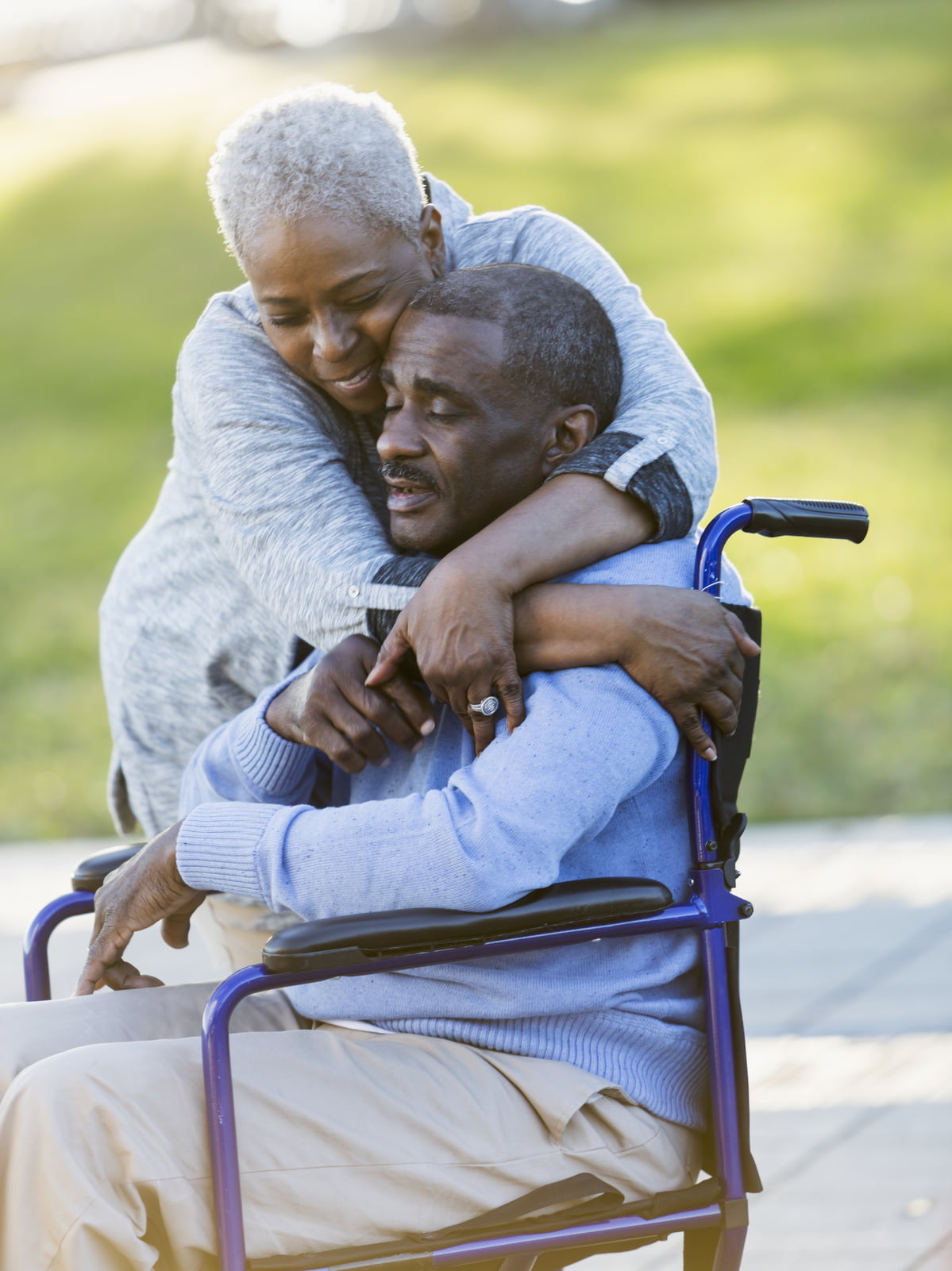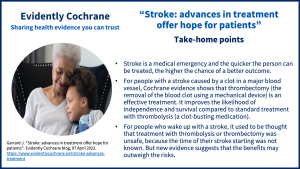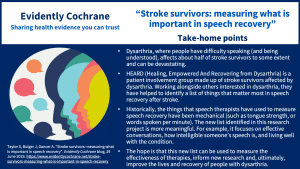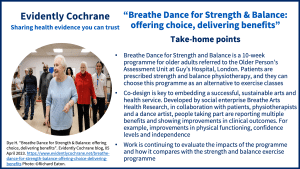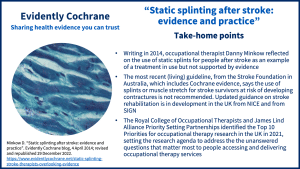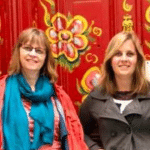On this page, you can find our blogs about different aspects of stroke. Many of them include research evidence and also reflections from people affected by stroke themselves, health professionals involved in the care of people with stroke and stroke researchers. There are also links to helpful resources.
- Information after stroke – what’s helpful?
- New treatments
- Dysarthria (unclear speech) after stroke
- The impact of stroke – Caroline’s story
- Physiotherapy-based dance to improve strength and balance
- Static splinting
- Living and dying well after stroke
- Research participation
- Resources
1
Information after stroke – what’s helpful?
In their blog Giving information after stroke: what’s helpful? (December 2022) James Garrard (Specialist Registrar in Stroke and Geriatric Medicine) and Annette Dancer (stroke survivor and research advisor) give their reflections on giving information to people after stroke, and look at the evidence on what might be helpful for stroke survivors and their carers.
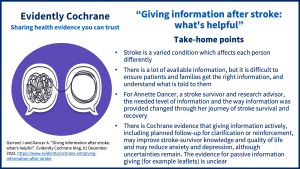
2
New treatments
In this blog Stroke: advances in treatment offer hope for patients (April 2022), for people interested in stroke treatment, James Garrard, Specialist Registrar in Stroke and Geriatric Medicine, reflects on his experience as a doctor working in a stroke centre and looks at the latest evidence and some game-changing developments in treatments for some stroke patients.
3
Dysarthria (unclear speech) after stroke
Stephen Taylor, Joe Bugler, and Annette Dancer are three stroke survivors affected by dysarthria (unclear speech). They are also members of HEARD (Healing, Empowered And Recovering from Dysarthria), a patient involvement group which has helped to shape research to identify the things that matter most in speech recovery after stroke. In this blog, Stroke survivors: measuring what is important in speech recovery, they tell us more.
Annette Dancer first wrote about her experiences of dysarthria here, in a blogs with Claire Mitchell, speech and language therapist and researcher – Sorry, what did you say? Living with dysarthria (unclear speech) after stroke (August 2017).
Annette also wrote a blog about Confidence after stroke: dating with dysarthria (March 2018). Annette had a stroke in 2014 and avoided social interactions because of her dysarthria. She believes that involvement in research has helped her to conquer fears of new relationships by putting dysarthria into perspective. This blog shows how her research experience helped her to see a potentially deflating experience turned into a step forward. Annette has also shared her experiences of The surreal side of life after stroke (March 2018).
4
The impact of stroke – Caroline’s story
In her blog, I miss me (March 2018) Caroline Carus reflects on some of the impacts of her stroke, one year on. “I miss me, the old me, the gone me”…
5
Physiotherapy-based dance to improve strength and balance
Breathe Dance for Strength & Balance is a 10-week dance-based physiotherapy programme for adults prescribed strength and balance physiotherapy. These include, but aren’t limited to, people who have had a stroke. In the blog Breathe Dance for Strength & Balance: offering choice, delivering benefits (April 2023) Hannah Dye from Breathe Arts Health Research explains how their innovative dance programme provides an alternative to exercise classes for older adults prescribed strength and balance physiotherapy at Guy’s Hospital, London. Created with patients, the programme is offering people choice in their healthcare pathway and bringing multiple benefits.
6
Static splinting
In the blog Static splinting after stroke: evidence and practice Danny Minkow, studying for an MSc in Occupational Therapy, invites other students and therapists to consider the problem of continuing use of therapies which lack evidence to support them or have been shown to be ineffective, and explores this in relation to splinting and stretching as stroke rehabilitation interventions. In December 2022, Sarah Chapman from Cochrane UK revised and republished this 2014 blog with recent evidence and guidance.
7
Living and dying well after stroke
The blog Living and dying well after stroke (March 2018) continues to draw a large number of readers and many comments and we are glad that many people are finding something helpful here. In the blog, Scott Murray and Marilyn Kendall talk about the rich evidence from their in-depth interviews, which could guide provision of person-centred care after major stroke and support people in living and dying well.
8
Research participation
In their blog Research is better together: a stroke survivor and a researcher tell us why (March 2018) Annette Dancer and Claire Mitchell give us their perspectives on why research is better when researchers and people affected by stroke work together, and what they gained from their collaboration.
Both Claire and Annette, along with two other stroke survivors affected by dysarthria, Stephen Taylor and Joe Bugler, were involved in recent research to identify the things that matter most in speech recovery after stroke. You can read about that in the blog Stroke survivors: measuring what is important in speech recovery.
If you’re interested to know more about the research or might be interested in opportunities to take part, Dr Claire Mitchell Claire.mitchell@manchester.ac.uk always wants to hear from stroke survivors living with dysarthria.
In the blog Stroke rehabilitation trials: let’s measure what matters (March 2018, updated August 2022) researcher and physiotherapist Julie Duncan Millar reflects on the difficulties of comparing and sharing upper limb rehabilitation trial data and proposes a condensed toolkit of measures recommended for researchers to use in future trials. The toolkit was developed by considering the stroke survivor, family and friend, clinician and researcher perspectives on life after stroke with upper limb dysfunction.
Other opportunities to take part in research:
The National Institute of Health Research page Be Part of Research has opportunities that you can search for by location and keyword (such as the name of a condition or treatment). They also have information about the stroke research projects they fund on their page Stroke.
9
Resources
NHS
- Stroke https://www.nhs.uk/conditions/stroke/
- NHS Inform (Scotland) https://www.nhsinform.scot/illnesses-and-conditions/brain-nerves-and-spinal-cord/stroke
UK guidance
- Stroke and transient ischaemic attack in over 16s: diagnosis and initial management – Information for the public from the National Institute of Health and Care Excellence (NICE)
- National Clinical Guideline for Stroke for the United Kingdom and Ireland from the Royal College of Physicians
- NICE Clinical Knowledge Summaries: Stroke and TIA
- Stroke rehabilitation in adults from NICE
UK Charities
Join in the conversation on Twitter with @CochraneUK or leave a comment on the blog.
Please note, we will not publish comments that link to commercial sites or appear to endorse commercial products. Please note, we cannot give specific medical advice and do not publish comments that link to individual pages requesting donations or to commercial sites, or appear to endorse commercial products. We welcome diverse views and encourage discussion but we ask that comments are respectful and reserve the right to not publish any we consider offensive. Cochrane UK does not fact-check – or endorse – readers’ comments, including any treatments mentioned.
Sarah Chapman and Selena Ryan-Vig have nothing to disclose.

